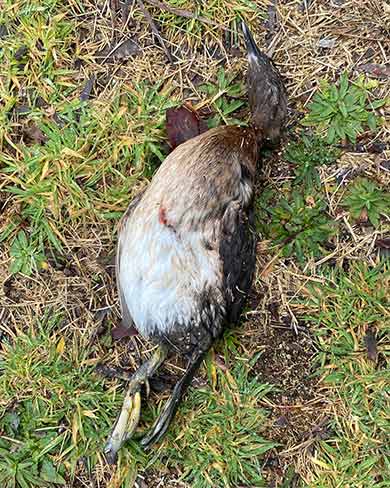Rotorua and Taupō are the main strongholds for dabchicks, with a total national population estimated at less than 2,500 individuals.
The endemic waterbirds suffered rapid decline during the 1800s and 1900s, but due to conservation efforts they are now increasing in numbers.
DOC Rotorua Operations Manager Zane Jensen says it's upsetting for DOC staff and conservation group members to see a healthy adult dabchick needlessly killed by a pet.
"The dabchick population in Rotorua is something we can be proud of; they can thrive here in our lakes, even with so many people and pets around.
"But with that privilege also comes the need for people in our community to be responsible pet owners, particularly when exercising dogs off-leash."

The deceased dabchick at Lake Ōkāreka
Image: M Boardman
The dabchick was found at Boyes Beach. The Rotorua Lakes District Council Dog Control Bylaw allows dogs to be exercised on or off a lead at Boyes Beach during specified times. The bylaw requires dogs to be under strict control of the person exercising the dog at all times, including when off-lead.
Boyes Beach links via a boardwalk to the DOC-managed Lake Ōkāreka Scenic Reserve. Dogs are not allowed to be taken into this reserve, as is the case for all DOC reserves in the Rotorua area. This is to protect our native wildlife from being disturbed, injured or killed by dogs.
"Many dogs have a natural urge to chase birds – it's up to owners to be on the lookout for risks and keep control of their dogs," says Zane.
An autopsy by Wildbase confirmed the bird, a healthy adult male, had been killed by a dog.
The natural environment at Lake Ōkāreka is highly valued by the community, with members of two local groups working tirelessly to protect and enhance biodiversity in the area.
Dabchicks are classified as threatened – nationally increasing, and are absolutely protected under the Wildlife Act 1953. Under the Dog Control Act 1996 the owner of any dog that attacks and causes the death of protected wildlife is liable on conviction to imprisonment for up to 3 years or a fine up to $20,000, or both; and the court may order the destruction of the dog.






